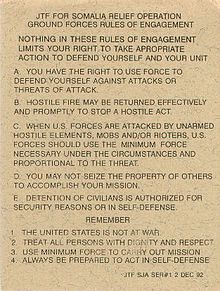Operation Provide Relief
Operation Provide Relief was a
Background

In January 1991, President of Somalia
In June 1991, a ceasefire was nominally agreed upon. In September 1991, the armistice was breached as fighting broke out again between Mogadishu factions. The armed confrontations continued in the following months and spread throughout the country, with over 20,000 people killed or injured by the end of the year.
These battles led to the destruction of the local agricultural sector, which in turn precipitated a food crisis in large parts of Somalia. The international community in response sent emergency rations. As a consequence, an estimated 300,000 people are believed to have died of starvation between 1991 and 1992.[3] In July 1992, after a ceasefire between the opposing southern-based clan factions, the United Nations sent 50 military observers to supervise the food supply distributions.
Humanitarian operation

Operation Provide Relief began in August 1992, when the
The Air Force C-130s delivered 48,000 tons of food and medical supplies in six months to international humanitarian organizations. When this proved inadequate to stop the massive death and displacement, the
After a long and protracted effort, the operation was eventually successful in saving many lives, as well as in de-escalating the high-intensity conflict into low-level, local skirmishes. However, the initiative has been criticized for expanding beyond its original boundaries ("mission creep"). The Washington-based Refugee Policy Group NGO in November 1994 suggests that any assessment of the success of Operation Provide Relief is "so fraught with methodological problems that it is rarely attempted." As such, it asserts that excess mortality had already peaked by the time that the first relief programs in and flights to southern Somalia were set up. The think tank offers a conservative estimate that about 100,000 lives were saved as a result of international assistance, 10,000 of which occurred after U.S. troops arrived in December 1992.[6]
See also
- Operation Restore Hope
- Operation Deliverance
- 2011 East Africa drought
References
- ^ Strednansky, Susan E. (1996). Somalia Case Study (Report). Air University Press. pp. 21–30.
- ^ Library Information and Research Service, The Middle East: Abstracts and index, Volume 2, (Library Information and Research Service: 1999), p.327.
- ^ "Twentieth Century Atlas – Death Tolls and Casualty Statistics for Wars, Dictatorships and Genocides". Users.erols.com. Retrieved 2011-04-20.
- ^ United Nations, Security Council resolution 794 (1992), 24 April 1992, para. 3
- ^ "UNITED NATIONS OPERATION IN SOMALIA II (UNOSOM II) - Background (Summary)". peacekeeping.un.org. Retrieved 2021-09-16.
- ISBN 978-1439188415.
Further reading
- Allard, Colonel Kenneth, Somalia Operations: Lessons Learned, National Defense University Press(1995)
